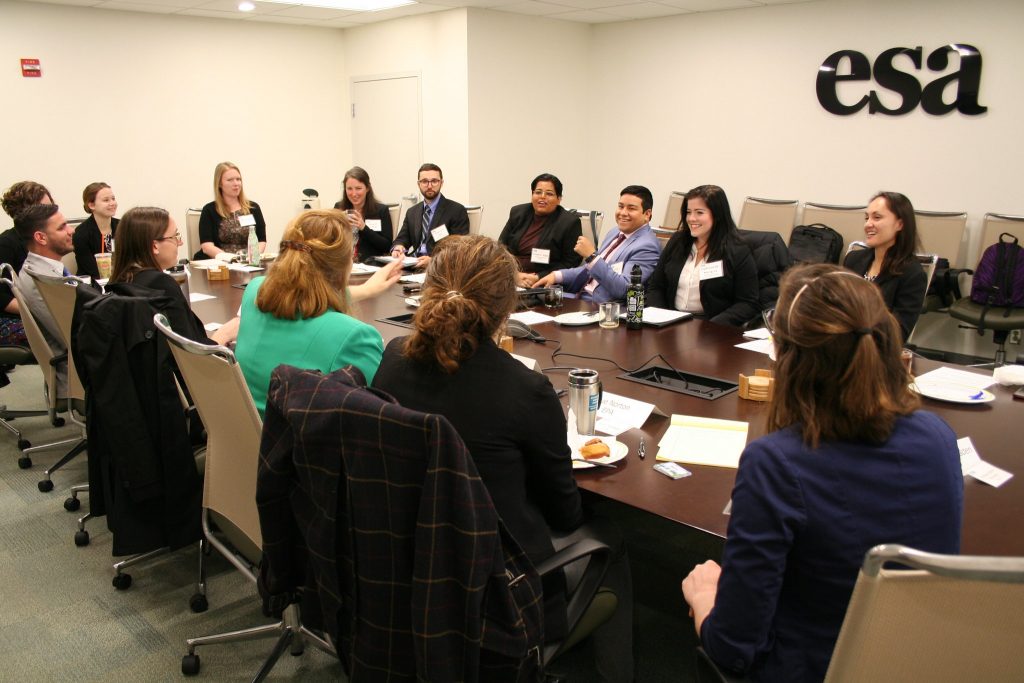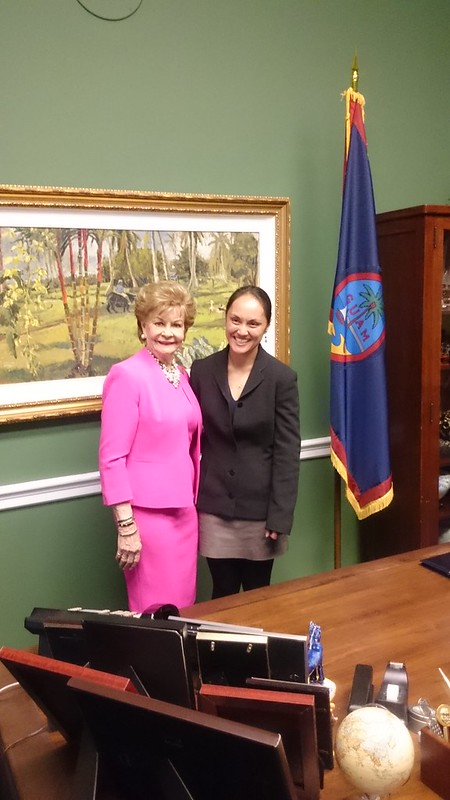Meeting with your lawmakers
How to Meet with your Lawmakers
Find your Members of Congress’ contact information
Find your members using the House’s Find Your Representative tool and the Senate’s Find Your Senators page. These pages include websites and phone numbers of each member of Congress. From there, you can call the member’s office and ask for the contact information for the staffer covering environmental or scientific issues as appropriate.
Request a meeting
Once you have the staffer’s email, send them a message requesting a meeting. The email should include 1) where you are from and how you are associated with the member’s district (i.e. you are a constituent or your institution is in their district) 2) what issue you would like to discuss and 3) when you can meet.
Here’s a sample message:
Email subject line: [Date], Constituent Meeting Request
Dear {staffer with staffer with science and/or environment portfolio},
I am constituent of Senator X/Representative X and a [scientist/graduate student/professor] at [organization]. I will in DC on [Date].
I would appreciate a brief meeting with you to discuss [X issue] and its contribution/impact to [state/district]. I will be joined by [a] colleague [colleague’s name and relevance as applicable].
What time do you have available for a meeting [date]? Thanks in advance for your help.
Preparing for a Meeting
Formulate a Message
Know what you want: Determine your “Ask”—what you would like the lawmaker to do. For example, “I’m here to encourage the Senator’s support for the proposed increase in the President’s budget aimed to address how the nation will meet its water resource needs.”
Choose a few take-home messages: Distill your message into a handful of key points—no more than three. Consider why you requested the meeting, why your concerns should matter to the staffer and lawmaker and what action you would like to see.
Stay positive: Given the nature of contemporary environmental concerns, ecological scientists may be perceived as focusing on “doom and gloom” scenarios. Try to focus on progress, solutions and success stories—what policymakers can do.

ESA Graduate Student Policy Award recipients discuss communicating their science with congressional offices during training at ESA headquarters.
Be succinct: The average meeting with congressional staff lasts about ten minutes. Meetings with committee staff may run longer, but brevity is still desirable.
Use anecdotes and numbers: Come equipped with facts and figures that back up your main message and offer a compelling anecdote that further underscores your point. If applicable, provide an estimated cost of inaction, particularly in terms of regions or resources of likely interest to the office.
Make it relevant: Congressional offices are concerned first and foremost with their district and state. A lawmaker’s voting record and committee assignments can give you insights to help you frame your message in a way most likely to resonate.
Limit jargon and acronyms: Particularly in congressional offices, staffers are generalists who manage wide-ranging portfolios. Don t assume that they’ll know technical terms or acronyms specific to ecology (e.g., LTER).
Be prepared for pushback. Anticipate and be prepared to respond to arguments against your request.
Ask Yourself:
Is my message succinct and understandable? Try it out: Give your pitch to someone not deeply familiar with the issue.
Think about your desired outcome(s). Is your main goal to share scientific information? Or is it to advocate for specific policy or action?
How can I be most helpful? Figure out the key issues in the debate and determine what kind of information would be most helpful.
Who is my audience? Tailoring your message to your audience will improve your ability to communicate constructively.
- Understand the cultural differences and varying backgrounds of congressional lawmakers.
- Research your audience’s record and current position on the issue. Are they supportive? Skeptical? Opposed? Just as you don’t want to preach to the choir and spend valuable time telling lawmakers what they already know, you don’t want to be presumptuous about support. You can research the lawmaker’s position by searching their website and past bills
- Anticipate your audience’s existing knowledge of the subject and prepare for your meeting accordingly. Think about how you are most likely to be misunderstood.
Develop a Leave Behind Document
- A one-page summary of key points
- Includes visuals that help to illustrate your message
- Can be used as a reference during your meeting
Here are a few examples of leave behind documents
- 2018 NSF State Fact Sheet for California
- 2016 Graduate Student Policy Award Fact Sheet
- NSF Fact Sheets
At Your Meeting

GSPA recipients Sara Gonzalez (L, University of California, Santa Cruz) and Vanessa Constant (R, Oregon State University) outside Sen. Ron Wyden (D-OR)’s office. Note the business attire!
Business attire is standard: No Birkenstocks or chacos!
Be punctual: If you arrive early, remain in the hallway until shortly before your scheduled meeting. offices and waiting areas can be crowded.
Gratitude goes a long way: Try to start and finish meetings with thank you.
Avoid partisanship: Do not make negative remarks about other offices and, if a staffer criticizes a party or lawmaker, respond politely but neutrally.
Exercise common sense: The Hill is tightly networked. Since you never know who might overhear, save any criticism of an office or individual for after you are off the Hill.
Know What to Expect
Timing: Be prepared to wait. If you’re scheduling several meetings in one day, be sure to leave ample time between meetings since staffers can run behind schedule. Though many meetings happen on time, in some cases you may need to wait between five and fifteen minutes.
Location: Staffers may hold meetings in the office lobby, small conference room, or even the lawmaker’s office, if he or she is out. But when things are busy, the hallway may be the only option. Venue has little to do with value — productive meetings can take place while participants are standing.
Personal Office: Congressional staff, especially in the House, are often early-career generalists with backgrounds in political science or history. Although they may not have deep knowledge on the meeting topic, they are typically ambitious and intelligent, and they have the ear of the lawmaker and are responsible for most of the work related to whatever topic you are discussing. Important connections and conversations are possible at all staff levels.

2018 GSPA recipient Ann Marie Gawel (Iowa State University) meets with Del. Madeline Bordallo (D-Guam).
Structure:
- Introductions, card swap: After brief introductions, names and affiliations staffers usually hand out their card. If you have business cards, be sure to bring them. Alternately, you can point to contact information on your leave-behind.
- Thank you: Thank the staffer for taking the time to meet with you. If the lawmaker has been supportive in the past, it’s also helpful to begin the conversation by saying that you appreciate the Representative or Senator’s work.
- The Ask /main message: Get to the point quickly staffers expect this (if you beat around the bush, they’ll often ask if you have a specific request). Do not suggest a program that could be cut to increase funding for your request.
- Examples: Once you’ve stated the purpose of your visit, back it up with facts, figures and anecdotes. Remember that this should be a dialogue and allow time for questions.
- Restate your message: Conclude by reiterating your Ask, which should be on your leave behind/one-pager, offer future assistance and say you appreciated the meeting.
After Your Meeting
Follow up promptly: Email a thank you note a day or two after your meeting. For example:
It was a pleasure meeting with you on [DATE] to discuss the importance of federal investment in biological research through the National Science Foundation (NSF).
As we discussed, sustaining our economic competitiveness requires a long-term investment in fundamental scientific research and education programs. A robust investment in NSF for the coming fiscal year will help produce the new knowledge and scientists who will drive innovation, create new jobs and help address the nation s energy, resource and environmental challenges.
Thank you again for your time. Please contact me if I can be of assistance to you.
Keep in touch: To establish a relationship, you’ll need to contact the office with some regularity. Scheduling meetings while in town is important, but written correspondence can be effective too,
If you’ve connected with a staffer in the office you can modify much of the letter accordingly. To build upon an initial meeting, send along useful follow-up information, such as a key contact or useful reference. Choose wisely though spamming an office is counterproductive. Try to touch base several times a year.
Take advantage of district work periods: In August, as well as several weeks surrounding federal holidays, lawmakers return to their home states and districts specifically to connect with their constituents. These periods can offer a more substantial interaction since the lawmaker has fewer demands than when in Washington, DC. Also, consider inviting staffers or lawmakers for a tour of your institution or field station.